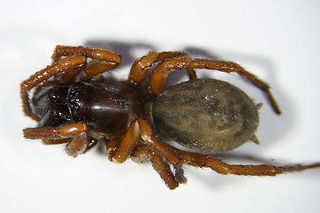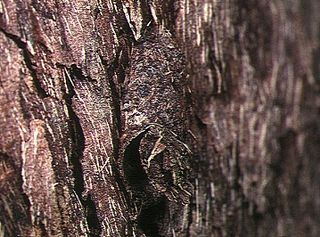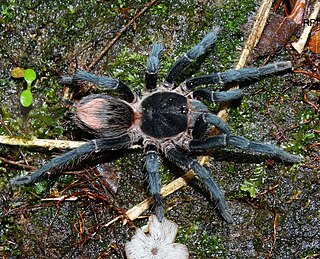
The family Dipluridae, known as curtain-web spiders are a group of spiders in the infraorder Mygalomorphae, that have two pairs of booklungs, and chelicerae (fangs) that move up and down in a stabbing motion. A number of genera, including that of the Sydney funnel-web spider (Atrax), used to be classified in this family but have now been moved to Atracidae.

Ctenizidae is a small family of mygalomorph spiders that construct burrows with a cork-like trapdoor made of soil, vegetation, and silk. They may be called trapdoor spiders, as are other, similar species, such as those of the families Liphistiidae, Barychelidae, and Cyrtaucheniidae, and some species in the Idiopidae and Nemesiidae. The name comes from the distinctive behavior of the spiders to construct trapdoors, and ambush prey from beneath them.

Hexathelidae is a family of mygalomorph spiders. It is one of a number of families and genera of spiders known as tunnelweb or funnel-web spiders. In 2018, the family was substantially reduced in size by genera being moved to three separate families: Atracidae, Macrothelidae and Porrhothelidae.

Barychelidae, also known as brushed trapdoor spiders, is a spider family with about 300 species in 39 genera.

Cyclocosmia is a genus of mygalomorph trapdoor spiders in the family Halonoproctidae, first described by Anton Ausserer in 1871. Originally placed with the Ctenizidae, when the family split in 2018, this genus was placed with the Halonoproctidae as the type genus. The name is derived from the Greek "kyklos" (κυκλος), meaning "circle", and "kosmeo" (κοσμεω), meaning "to adorn".

Porrhothele is a genus of mygalomorph spiders endemic to New Zealand. They are the only members of the family Porrhothelidae. They were first described by Eugène Louis Simon in 1892. Originally placed with the curtain web spiders, it was moved to the Hexathelidae in 1980, they were placed in their own family in 2018.

Coelotes is a genus of funnel weavers first described by John Blackwall in 1841. A large number of species are found throughout Europe and Asia.

Chilobrachys is a genus of Asian tarantulas that was first described by Ferdinand Anton Franz Karsch in 1892. They are found in India, Myanmar, Malaysia, China, Vietnam, Thailand and Sri Lanka. They are usually medium or large-sized, and they can stridulate by using small spines present on the chelicerae.

Hexathele is a genus of tunnelweb spiders endemic to New Zealand that was first described by Anton Ausserer in 1871, though most others have been described by Raymond Robert Forster. Originally placed with the curtain web spiders, it was moved to the Hexathelidae in 1980.

Latouchia is a genus of Asian mygalomorph spiders in the family Halonoproctidae, first described by Reginald Innes Pocock in 1901. Originally placed with the Ctenizidae, it was moved to the Halonoproctidae in 2018.

Phlogiellus is a genus of tarantulas that was first described by Reginald Innes Pocock in 1897. They are found throughout Asia and Papua New Guinea, including Indonesia, the Philippines, Papua New Guinea, China, Myanmar, Malaysia, Borneo, Thailand, the Solomon Islands and Taiwan. Phlogiellus is part Latin and part Greek, the first part being "φλóξ φλoγóϛ", meaning flame, the second part being "ellus" which is a latin diminutive suffix.
Psechrus is a genus of cribellate araneomorph spiders in the family Psechridae, and was first described by Tamerlan Thorell in 1878.

Conothele is a genus of mygalomorph spiders in the family Halonoproctidae, first described by Tamerlan Thorell in 1878. Originally placed with the Ctenizidae, it was moved to the Halonoproctidae in 2018.

Homoeomma is a genus of South American tarantulas that was first described by Anton Ausserer in 1871. It is considered a senior synonym of Calopelma, Butantania, and of Cyclothoracoides. These tarantulas are usually quite small and usually burrow a few centimeters under a rock or log.
Sinopesa is a genus of spiders in the family Nemesiidae. It is found in China and on Ryukyu Islands in Japan. It was first described in 1995 by Raven & Schwendinger. As of 2023, it contains 8 Asian species.

Macrothelidae is a family of mygalomorph spiders, split off from the family Hexathelidae in 2018. It contains three genera, Macrothele,Vacrothele and the extinct Promacrothele.
Hermachola is a genus of southern African mygalomorph spiders in the family Entypesidae. It was first described by J. Hewitt in 1915, and it has only been found in South Africa. As of November 2021 it contains only three species: H. capensis, H. crudeni, and H. lyleae. It was previously considered a junior synonym of Hermacha , but was elevated to genus in 2021. The type species, Hermachola crudeni, was originally described under the name "Hermacha crudeni".















